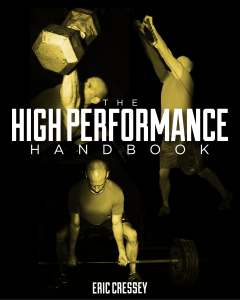
7 Ways to Make Your Strength Training Programs More Efficient
I’m a big believer in pursuing maximum efficiency in our training programs. We want exercises and training strategies that deliver the biggest “bang for our buck,” as most people don’t have all day to spend in the gym. That said, supersets, compound exercises, and other well-known approaches on this front are staples of just about all my programs.
Unfortunately, sometimes, the typical strategies just don’t get the job done sufficiently. There are periods in folks’ lives that are absurdly busy and require approaches to kick the efficiency up a notch further. With us opening a new facility right as our busiest season is upon us – and my wife pregnant with twins – you could say that this topic has been on my mind quite a bit these days. With that in mind, here are seven strategies you can utilize to get a great training effect as efficiently as possible.
1. Switch to a full-body split.
Let’s face it: you might never get in as much work on a 3-day training split as you do on a 4-day training split. However, you can usually get in just as much high quality work. I’ve always enjoyed training schedules that had me lifting lower body and upper body each twice a week. However, usually, the last few exercises in each day are a bit more “filler” in nature: direct arm work, secondary core exercises, rotator cuff drills, and other more “isolation” drills. In a three-day full-body schedule, you should really be just focusing on the meat and potatoes; it’s the filler you cut out.
Additionally, I know a lot of folks who actually prefer full-body schedules over upper/lower splits. This was one reason why I included 2x/week, 3x/week, and 4x/week strength training options in The High Performance Handbook.
2. Do your foam rolling at another point during the day.
There has been a lot of debate about when the best time to foam roll is. While we generally do it pre-training with our athletes, the truth is that the best time is really just whenever it’s most convenient – so that you’re more likely to actually do it! If you’d rather foam roll first thing in the morning or at night right before bed, that’s totally fine. As long as you get it in, over the long haul, you really won’t see a difference if you compare pre-training to another point in the day.
3. Do a second, shorter session at home. (Waterbury, PLP program example)
Remember that not all training sessions have to actually take place in a gym. Rather, you might find that it’s possible to get in 1-2 of your weekly training sessions at home. As an example, I have an online consulting client who has a flexible schedule on the weekends, but a crazy schedule during the week. He does two challenging sessions with heavier loading on the weekends (lower body on Saturday and upper body on Sunday). Then, he’ll work in some filler work with body weight, band, and kettlebell exercises on Tuesday and Thursday. He’s still getting in plenty of work in during the week, but he doesn’t have to set aside extra time to drive to and from the gym. Obviously, a home gym alone can make for more efficient programs, too!
4. Move to multi-joint mobility drills.
If you’re in a rush to get in a great training effect – and abbreviated warm-up – don’t pick drills that just mobilize a single joint. Rather, pick drills that provide cover a lot of “surface area.” Here are a few of my favorites, as examples:
Typically, you’re going to want to do fewer ground-based drills and more drills where you’re standing and moving around.
5. Dress in layers.
Speaking of warm-ups, it’ll take you longer to warm-up if you dress lightly – especially as the winter months approach. Athletes always comment that they get (and stay) warm better when they wear tights underneath shorts, or sweatshirts and sweatpants over t-shirts and shorts. Of course, you can remove layers as you warm up.
Additionally, if you’re an early morning exerciser, you can expedite the warm-up process by taking a hot shower upon rising. A cup of coffee can help the cause as well.
6. Add in mobility fillers.
If you’re going to shorten the warm-up a bit, you can always “make up” for it by working in “fillers” between sets of your compound exercises. I actually incorporate this with a lot of the programs I write, anyway. If you look at our baseball athletes, they’re often doing arm care drills in between sets of squats, deadlifts, and lunges. They get in important work without making the sessions drag on really long, but at the same time, it paces them on the heavier, compound exercises so that they aren’t rushing.
7. Use “combination” core movements.
Usually, the word “core” leads to thoughts of unstable surface training, thousands of sit-ups, or any of a number of other monotonous, ineffective, flavor-of-the-week training approaches. In reality, the best core training exercises are going to be compound movements executed in perfect form. Overhead pressing, Turkish get-ups, 1-arm pressing/rows/carries, and single-leg movements (just to name a few) can deliver a great training effect. Complement them with some chops/lifts, reverse crunches, dead bugs, and bear crawls, and you’re pretty much covered.
There are really just seven of countless strategies you can employ to make your training programs more efficient. Feel free to share your best tips on this front in the comments section below. And, if you’re looking to take the guesswork out of your programming, I’d encourage you to check out The High Performance Handbook, the most versatile strength and conditioning program on the market today.



